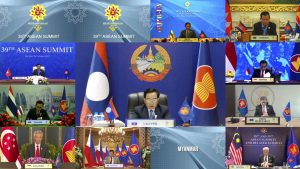Emerging out of the recent series of ASEAN gatherings, including the summit, the most potent issue is how the bloc will deal with Myanmar, which has remained mired in turmoil since its coup in February this year. An emergency meeting of ASEAN foreign ministers ahead of the ASEAN Summit decided that ASEAN would not invite representatives of Myanmar’s military government to the summit, instead allowing a “non-political representative” to attend. Myanmar decried this decision and ultimately did not send a representative to the summit. It was the first time in the history of ASEAN that a summit was not attended by all members of the organization.
Myanmar’s military government has said that the decision violated ASEAN’s principle of decision-making by consensus. Meanwhile, the ASEAN Summit adopted a Chairman’s Statement that went further than expected in encouraging Myanmar to rethink its position. The Statement explicitly called for a full commitment to, and “timely and complete” implementation of, the Five-Point Consensus that was agreed at a special ASEAN summit held in April this year to discuss Myanmar. Even more noteworthy is that the Chairman’s Statement includes the wording “While respecting the principle of non-interference, we reaffirmed our adherence to the rule of law, good governance, the principles of democracy and constitutional government as well as the need to strike an appropriate balance to the application of ASEAN principles on the situation in Myanmar.” Media reports suggest that this is a reflection of the will of some countries, including Indonesia, to resolve the stalemate in Myanmar. In fact, the wording reveals that there are essentially two contradictory directions for the kind of “community” that ASEAN is aiming to be.
ASEAN had signaled its intention to form a regional community since its inception, but the specific policy agenda for this was the declaration of the ASEAN Concord II in 2003, which declared the building of an ASEAN community. In December 2015, the ASEAN community building was announced based on the three pillars of political-security community, economic community, and socio-cultural community. Meanwhile, in 2008, the ASEAN Charter came into effect as an establishment treaty suitable for a system aimed at community building. With the ASEAN Charter, the “community” that ASEAN aims to be was given elements different from the kind of “community” that ASEAN has traditionally aspired to represent.
The “community” that ASEAN has traditionally sought was a “no-war community,” where members make decisions based on the consensus principle while also adhering to the non-interference principle, resolving disputes peacefully without using force against each other. This was a necessary element for the ASEAN countries to overcome the mutual distrust and conflicts that prevailed in the early days of the organization’s in the 1960s. The orientation was maintained as ASEAN expanded in the 1990s. If the ASEAN framework were to exist in Southeast Asia as a mechanism to stabilize relations between neighboring countries while protecting them through the non-interference principle, it should logically be able to accept any country regardless of its system of government.
However, while the ASEAN Charter reaffirmed the non-interference principle and other traditional ASEAN norms, it identified the purpose of ASEAN as “to strengthen democracy, enhance good governance and the rule of law, and to promote and protect human rights and fundamental freedoms.” It also specified one of its principles as “adherence to the rule of law, good governance, the principles of democracy and constitutional government.” This signifies that ASEAN is working toward becoming a community with democratic political systems and human rights protections. It may be considered an orientation toward the kind of “security community” once suggested by international political scientist Karl Deutsch.
Needless to say, the two community orientations contradict each other. The non-interference principle is a traditional norm in the international system. On the other hand, calling for the promotion of democracy and protection of human rights means requiring a certain standard in terms of how the political system works in a given country and how that country’s government treats the rights of its citizens. This is not possible if you strictly adhere to the non-interference principle. Since the enactment of the Charter, ASEAN has been pursuing these two mutually contradictory community-oriented paths. It was able to get by with a foot in each camp as long as there was no pressing need to make an ultimate decision about which direction to take. In fact, since the countries in ASEAN actually occupy various positions on human rights and democracy, this strategic “ambiguity” of ASEAN was both effective and necessary.
Nevertheless, the eruption of extreme violence in Myanmar has made it impossible for ASEAN to maintain this strategic ambiguity, forcing the organization to choose which community orientation it will adopt. There may not be a full consensus among the ASEAN countries yet, but it is very significant that the leaders of ASEAN countries other than Myanmar, including Cambodia and Thailand – two countries where democracy has been in retreat – gave a green light to a Chairman’s Statement that includes the aforementioned text.
While it is unlikely that ASEAN will wholeheartedly commit itself to a “security community” track just yet, it also is far from obvious that ASEAN will remain an organization that merely seeks to stabilize traditional international relations. A new direction for the organization has clearly been shown.

































